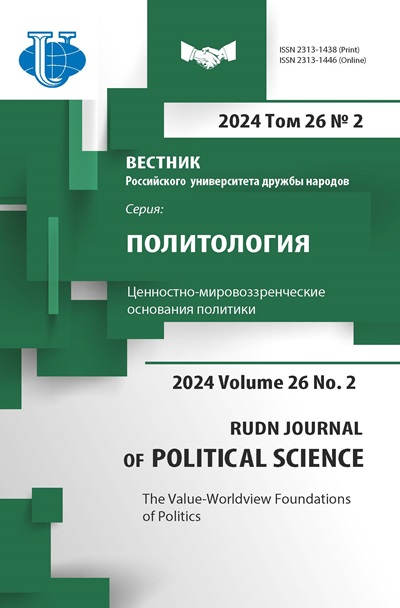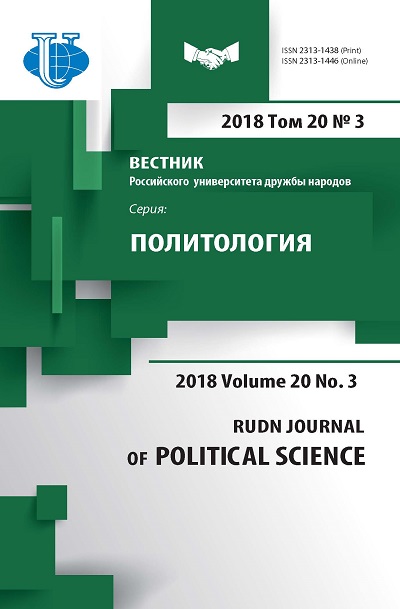МЕТОДЫ МЕЖДУНАРОДНОГО СООБЩЕСТВА ПО ОКАЗАНИЮ ПОДДЕРЖКИ ГОСУДАРСТВАМ В РЕШЕНИИ ПРОБЛЕМ БЕЖЕНЦЕВ
- Авторы: Альзубейди А.М.1
-
Учреждения:
- Российский университет дружбы народов
- Выпуск: Том 20, № 3 (2018)
- Страницы: 397-407
- Раздел: Политические процессы в современном мире
- URL: https://journals.rudn.ru/political-science/article/view/19641
- DOI: https://doi.org/10.22363/2313-1438-2018-20-3-397-407
Цитировать
Полный текст
Аннотация
В данной статье рассматриваются решения, предлагаемые международным сообществом странам, страдающим от постоянного притока беженцев и нуждающимся в международной помощи. Миграция беженцев является одним из видов вынужденной миграции. После введения международно-правового статуса беженцев международное сообщество использует одно из трех решений проблемы беженцев: добровольную репатриацию, местную интеграцию и расселение в третьей стране. В статье рассматривается расселение в третьи страны как основное решение глобальной проблемы беженцев, которое должно быть использовано в больших масштабах. В статье также рассмотрены случаи вмешательства во внутренние дела развивающихся стран и роль такого вмешательства в обострении проблемы беженцев. Несмотря на благожелательность намерений, таких, как защита прав человека, эти интервенции в некоторых случаях продемонстрировали обратный эффект, например в Ираке, Афганистане и Ливии. Автор затрагивает важность мирных путей решения и предотвращения проблемы беженцев. Также в статье отмечается новый подход международного сообщества к проблеме беженцев: интеграция проектов развития и программ поддержки беженцев в странах, нуждающихся в этом виде помощи.
Об авторах
Ахмед Мохаммед Альзубейди
Российский университет дружбы народов
Email: zbaidy22@gmail.com
аспирант кафедры сравнительной политологии Российского университета дружбы народов (Иордания) ул. Миклухо-Маклая, 6, Москва, Россия, 117198
Список литературы
- Al-Nazir S., Al-Khalifa A. Humanitarian Intervention but Its Legitimacy and Types. Journal of Justice (Ministry of Justice - Sudan). 2013; 38.
- Al-Rashidi A. The Right to Seek Asylum as a Human Rights Application, a Comparative Study in the Light of International Covenants and Some Constitutions and Arab Legislation: Symposium on International Protection of Refugees. Center for Research and Political Studies, Faculty of Economics and Political Science, Cairo University, 17-18 November 1996: 67.
- Al-Tamawi S. The General Principles of Administrative Contracts. Cairo: Dar Al-Fikr; 2005: 634.
- AL-Zubaidi A.N. The State's Ability to Commit to the Legal Protection of Refugees. Master Thesis. Jordan: Jadra University: 14.1.
- Amnesty International Website. 8 Ways to Resolve the Global Refugee Crisis. Available from: https://www.amnesty.org. Accessed: 11.02.2018.
- Astiah F. Asylum in the Jordanian and International Law (Legal Comparative Study). Master Thesis. Amman: Amman Arab University; 2014. 38 p.
- Dimitri A. National Reconciliation Duty and Responsibility. The Writer - Egypt. 1973; Vol. 13; 143.
- Gillard Van G. Law Among Nations: An Introduction to International Public Law (Part I). Beirut: New Horizons Publishing House; 1970: 24.
- Jumaili A.S.H. Intervention in the Occupation: A Proposed Term under International Law. Rafidain. 2013; 56.
- Khalil J. The Legitimacy of the Use of Force in International Relations Applied on US Policy Toward Iraq, the Years 1990-2003. Financial and Commercial Research Journal (Faculty of Commerce, University of Port Said). 2008; 2: 276.
- Mahmoud R.Y. Sharing Responsibility for Refugees and Respect for International Law. Al-Manara Journal for Legal and Administrative Studies. Morocco; 2017: 124.
- Sheikh Mohammed A.H. The Dimensions of Humanitarian Intervention of the United Nations in the Events of the Arab Revolutions: Libya and Syria, a Model. The Arab Journal of Political Science. 2014; 44-43: 134.
- UNDP. Capacity Building for Crisis Response: Response to the Syrian Crisis. UNDP. 11.03.2015: 3.
- UNHCR. Where we Work: Asia and the Pacific. UNHCR. Available from: http://www.unhcrarabic.org/pages/4be7cc27916.html. Accessed:11.2.2018.
















